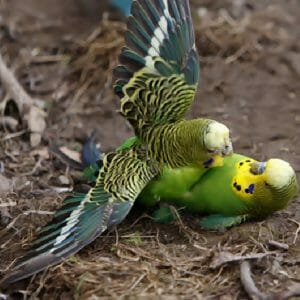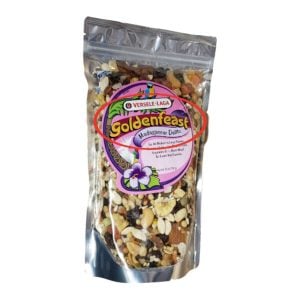
Tips to Prevent Feather Picking Environmental Enhancement
Tips to Prevent Feather Picking Environmental Enhancement
Last Updated on by Mitch Rezman
TIPS TO PREVENT FEATHER PICKING
ENVIRONMENTAL ENHANCEMENT
By CharlieHarding
Thisis an outline of an audio tape narrated by CharlieHarding on Parrot
Behavior Modification.
Rarely is abnormal parrot behavior due to one specific factor. Ratheritis often
due to a number ofissuesrelated to the parrot’s environment and how the
ownerrelatesto the bird. The following is a list ofimportanttopicsthat each
clientshould think about and possibly alterto enhance the behavior of his or
her pet parrot.
THE MAJOR ISSUES
1. Diet
2. Mental Stimulation – Toys
3. Bathing
4. Sleep
OTHER IMPORTANT ISSUES
5. Humidity, Light, and Sound
6. Smoking –Nicotine
7. Time out ofthe Cage
8. Wing Trimming and the
“Step‐up” Command
DIET
KEY POINTS:
AVOIDANALL SEEDDIET. PELLETS ARE RECOMMENDED. FEEDLOTSOF
TROPICAL FRUITS AND VEGETABLES. VARIETY IS IMPORTANT – IT BECOMESMONOTONOUS ANDBORING IF THE SAME THING IS EATENEVERYDAY. GOOD
NUTRITIONKEEPSAPARROT AT PEAK PERFORMANCE ANDTHISAFFECTS
BEHAVIOR ANDPERSONALITY.
1. Avoid a dietthatis primarily seeds, especially sunflowerseeds,
safflowerseeds, and peanuts.
2. Think aboutit – parrots do not eatthese kinds offood in thewild.
These seeds may give birds a high – it’slike ustaking in lots of caffeine.
3. Seedsshould not make up more than 20% ofthe daily food intake.
Lessis even better.
4. Acommercial pelleted dietisrecommended. Itshould make up about
60% ofthe diet.
5. Feed lots oftropicalfruitssuch as mango, papaya, kiwi, banana,
passion fruit, etc.
6. Avoid citrusfruits – these are too acidic.
7. Offerfresh fruits whenever possible. Frozen is next best,then canned,
and then dried.
8. Offer dark green, leafy vegetables.
9. Beans, lentils,rice, yams,sweet potatoes, cooked rice, pasta, breads
and nutritious cereals are all good additionsto the diet.
10.It may take persistence and imagination to come up with ways of
getting your bird interested and used to a new, more varied and
nutritious diet.
MENTAL STIMULATION‐ TOYS
KEY POINT:
PARROTSNEEDLOTSOF TOYS. OFFER THEM TOYS FROM EACHOF THE FOUR
CLASSIFICATIONS:
TEARUP TOYS, PUZZLE TOYS, PHYSICAL ACTIVITY TOYS, AND
PERMATOYS. ROTATE TOYS EVERY 7‐14DAYS.
1. Birds need lots oftoys
2. These should be evenly spaced and firmly attached along the back and
sides ofthe cage. They should notinhibit normal movementinside the
cage.3. Think of a parrot as a 3 year old child – they like lots oftoys. They also
have a short attention span and get bored quickly.
4. There are four classifications oftoys – parrots need them all.
a. Tear up, chew up, destroy type toys
1. Examples are things made of wood, leather, and rope
2. These kinds oftoys help parrots venttheirfrustration in a
positiveway. This decreasesstress and helpslessen the
likelihood of parrots chewing on household items and being
aggressive toward owners.
b. Puzzle toys – food interactive
1. Toysthat contain food or other desired itemsthattakesthe bird
atleast 5 minutesto open orremove.
c. Physical activity toys
1. Includesswings, ladders, and perches
2. These should be inside the cage
3. Ifthey don’tfit well,then mostlikely the cage istoo small which
can also lead to stress.
d. Perma or durable, long lasting toys.
1. These include toys made of metal, hard plastics, and acrylics.
5. Rotate toys every 7‐14 days. Have a box with extra toys available.
Every month orso, buy new toys.
6. If birds are afraid oftoys:
a. Start by putting the toy in the same room asthe bird. Every day
move the toy closerto the cage. Finally attach itto the outside of
the cage, down low. Then move it up. Then putitin the cage, but
down low. Slowly move it up towhere youwantto position itfor
severalweeks. This arouses curiosity and decreasesfear of a new
object.
b. Attach shelled seedsto the toywith Elmer’s glue
c. Letthe parrotsee you playingwith a new toy.BATHING
KEY POINT:
MIST YOUR BIRDDAILY. GIVE AHEAVY SHOWER AT LEASTONCEWEEKLY.
1. Most parrots come from the rainforest where itrains almost every day.
Assuch,they should get wet atleast once a day.
2. Bathing should be a positive experience ofsocialsignificance. When
you’re clean, you feel better. You don’titch as much.
3. Birdsshould receive a light misting atleast once a day. Weed sprayers, in
which you pump airinto a water canister, produce a fine mistwhich is
often non‐threatening to the bird.
4. Birdsshould receive a heavy shower once a week.
a. Can be in a regularshowerstall utilizing suction cup perches.
b. Can be in the sink ortub using a standard wantto spray down the bird.
c. This helpsremove excess dander, dust, and dirt.
SLEEP
KEY POINTS:
PARROTS SHOULDHAVEAT LEAST 10HOURSOFUNINTERRUPTEDSLEEP EACH
NIGHT. HAVINGA SLEEP CAGE THAT YOU CANPUT INA SEPARATE,DARKENED
ROOM IS AGOODSOLUTION.
1. When itis dark, parrotssleep orremain inactive.
2. Most parrots come from nearthe equator where the photoperiodism is
aboutthe same yearround.
3. In the wild, parrots probably sleep about 10 uninterrupted hours or more
each day.
4. In captivity, most parrots probably don’t get enough sleep, especially
uninterrupted sleep. Ifthe lights don’t go out until midnight and then
come on again at 7 AM (or whenever dawn occurs),then thisis not
enough. This may cause sleep deprivationwhich in turn may affect
behavior.5. Daytime naps may not help as much as we think. Thisislightsleep, and
not deep, uninterrupted sleep.
6. Solution? Have a sleep cage in a separate room. This can be a small,
inexpensive cage, just big enough for a perch, a fewtoys, and a place for
some food andwater.
7. Putthe bird in this cage and isolate him in a dark room for atleast 10
hours each night.
HUMIDITY
KEY POINT:
BIRDS SHOULDBE KEPT INANENVIRONMENTOFHIGHHUMIDITY (AT LEAST 55‐
60% ORHIGHER).
1. In the rainforest,the humidity is always high (90‐100%).
2. The humidity in the home should neverfall below55‐60%
3. High humidity is very importantin regardsto feather picking birds,
especially AfricanGreys and Cockatoos.
4. Waysto increase the humidity in your home:
a. Run a central orroom humidifierfor atleast 12 hours a day.
b. Have a 20+ gallon aquarium in the same room
c. Have a runningwater,table top fountain in the same room. Have it
operationalfor atleast 8 hours a day. Recommended to have the
fountain on a timer. This helps create an “event” in the parrot’s daily
routine.
FULL SPECTRUM LIGHTING
KEY POINTS:
FULL SPECTRUM LIGHTING IS IMPORTANT FOR BIRDS KEPT INDOORS. IT
SHOULDBEONFOR AT LEAST 8HOURSDAILY. IT MAKES BIRDS FEEL BETTER. IT
MAYHELPALLEVIATE FEATHER PICKING. USE FLUORESCENT FIXTURESOR
TUBES,NOT BULBS.1. Naturalsunlightisfull‐spectrum.
2. Itis very importantforthe overall, well‐being of animals. Itinvigorates
birds and helpsthem “feel good.” Itis also criticalfor VitaminD3
metabolism which in turn affects calcium absorption from theGItract.
3. Lowblood calcium may cause some birdsto feather pick, especially
AfricanGreys.
4. Glasswindowsfilter out ultravioletrays, which are the mostimportant
components offull‐spectrum light.
5. Full‐spectrum lightis especially importantforfeather picking birds. It
helps eliminate stress.
6. How much full‐spectrum lightshould a bird have each day? No one
knowsforsure, but up to 8 hoursisrecommended. They getthis much, if
not more, in the wild each day.
7. Full‐spectrum lightissuperiorin the form of a fluorescentfixture ortube,
notin a bulb.
8. Followcompany instructions on wattage required and distance lights
should be placed from the cage.
SOUNDS
KEY POINTS:
VARIOUS SOUNDS CANBEUSEDTOHELP PREVENT A STATIC ENVIRONMENT,
ESPECIALLY IF THE PARROT IS LEFT ALONE ALLDAY. USE TIMERS TOTURNON
THE RADIO, TV, ETC. TOCREATE “SOUND EVENTS.”
1. Birds are very sensitive to auditory stimulation.
2. Birds get bored easily ifthey are left at home alone all daywhile the
owners work, especially in an unchanging,static environment.
3. Birdsthrive on “routine” and “daily events.”
4. Timers can be used to create “sound event.” This can include the
automatic turning on and off ofthe radio, TV,table‐top fountain, etc. at
specified times each day.
5. Birdslike the sound ofrunning water – itis very soothing. These sounds
are fun and exciting and may mimic soundsin the jungle. These help
prevent a “static” environment.
6. Regular,relaxing sounds help decrease anxiety and stress.SMOKING ‐NICOTINE
KEY POINT:
NICOTINE CANCAUSE FEATHER PICKING. DON’T SMOKE AROUND YOUR BIRD.
WASHYOURHANDS REGULARLY IF YOUDO.
1. Second‐hand smoke (nicotine) can lead to feather picking.
2. Nicotine transfer can occur when a parrot comesin contactwith the skin,
hair and clothing of an owner who smokes.
3. Some birds are much more sensitive to nicotine than others.
4. Don’tsmoke around your bird.
5. Ownerswho smoke should always wash their hands before handling their
bird or any bird paraphernalia.
TIMEOUTOF THE CAGE
KEY POINTS:
BIRDS SHOULDBE ALLOWEDOUTOF THEIR CAGE FOR AT LEAST TWOHOURS
EACHDAY. THEOWNER MUST MAINTAINCONTROLOF THE BIRD’S COMING
ANDGOING WHICHHELPSDECREASE BAD BEHAVIORS.
1. Birdsshould be allowed out ofthe cage for a minimum of 2 hours each
day.
2. This can include being on a T stand, climbing tree, playpen, orjungle gym.
It’sOK ifit’sin the same room.
3. Allowing the bird to be away from its cage helps alleviate biting or
aggressive tendencies.
4. Being in other places also helps decrease stress and letsthe bird know
thatit’sOK to be elsewhere.
5. The regular cage providesstructure and guidance. Don’t allowthe bird
free accessto come and go from his cage as he chooses. You should
decide when the cage dooristo be opened orshut.
6. Too much independence makessome birds bite more.7. Avoid allowing the bird to be on top of his cage or on yourshoulder
excessively. This makes him feel like he’s “king ofthe hill.” Height
dominance leadsto aggression and biting tendencies.
8. By allowing the bird to be “in charge” you are increasing hisstress and
anxiety which lead to bad behaviors.
9. Birdsshould not be allowed to followyou throughoutthe house. This
also makesthem feel “in charge.”
10.Beware ofletting birdssee clearly out of windows. They may see things
that are stressfulto them that we don’t perceive assuch. Birds are very
“flight orientated” when stressed. Ifthey can’t get away because they are
cage,this may lead to more anxiety which mightincrease bad behaviors.
WINGCLIPPING
KEY POINT:
YOUHAVE MORE CONTROLOVER YOUR BIRD WHENHISWINGSARE CLIPPED
1. Parrots are generally less aggressive when their wings are clipped.
2. Thisis a “control issue” for birds. It preventsthem from flying away from
you.
3. Many birdswhosewings are clipped quickly learn thatifthey try to fly,
theywill only end up on the floor. And most birds don’tlike to be down
there. In thewild itis dangerousto be on the ground for any length of
time. Birds usuallywon’t bite you when you try to pick them up from the
floor because ofthisfact.
HANDLINGTHE BIRD– STEP‐UP COMMAND
KEY POINTS:
THIS IS THE MOST IMPORTANT COMMANDTHAT ALLOWS YOUTOBE IN
CHARGEOF YOUR PARROT. AVOIDLETTINGYOUR BIRDPERCHONYOUR
SHOULDER.
1. Teaching your parrotto “step up” on your hand is probably the most
important command to teach your bird.2. It helps you gain control and establishes you asthe “top bird.”
3. Once learned, birds willfollowthis command even when they wantto
bite you.
4. Teach this command in a loving, caring mannerso the bird willtrust you.
5. Avoid letting your bird sit on yourshouldertoo much. This makes him
feelthat he is on an equal or even superiorlevel with you asfar
dominance. You lose control.
6. Birdstend to relate mostly to your hands and head, and notso much to
your body.
7. If a bird is perches on yourshoulder and he seessomething threatening,
hewill bite at you – a form of misplaced aggression.
Author Profile

Latest entries
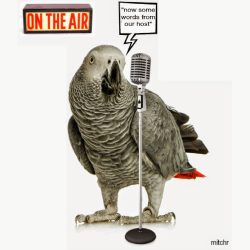 Bird & Parrot CareJune 20, 2025Understanding the Best Way to Use Prevue Pets Mimic Me Voice Trainer
Bird & Parrot CareJune 20, 2025Understanding the Best Way to Use Prevue Pets Mimic Me Voice Trainer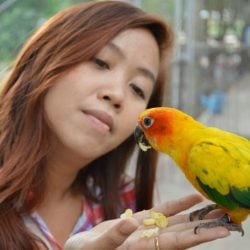 Bird BehaviorJune 6, 2025How Do I Keep My Parrot From Dumping His Food Every Day?
Bird BehaviorJune 6, 2025How Do I Keep My Parrot From Dumping His Food Every Day?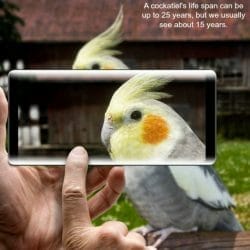 Birds & LightingMay 16, 2025I Am Seeking Clarity About Lighting for My Birds Cage
Birds & LightingMay 16, 2025I Am Seeking Clarity About Lighting for My Birds Cage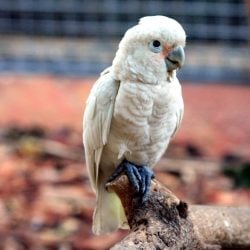 Bird RescueApril 29, 2025How Do We Re-Home a 17 yr Goffin Cockatoo?
Bird RescueApril 29, 2025How Do We Re-Home a 17 yr Goffin Cockatoo?
